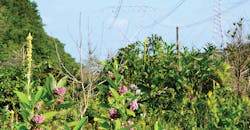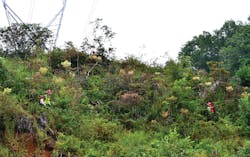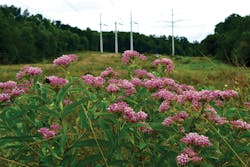Manage ROW Habitat and Reliability
A long-term integrated vegetation management pilot project began in 2008, near Annapolis, Maryland, after trees and brush were cleared from high-voltage electric transmission rights-of-way. The clearing was done to ensure compliance with North American Electric Reliability Corporation (NERC) FAC-003 clearance standards. After the clearing, an opportunity emerged for a partnership — facilitated by IVM Partners Inc. — with Baltimore Gas and Electric Co. (BGE) and the U.S. Fish and Wildlife Service (USFWS) to create an integrated vegetation management (IVM) plan.
Developed for a 5-mile section of rights-of-way (ROW) through the South River Greenway, an IVM plan was formed to meet the safety, access and reliability needs of the electric utility while also improving the habitat for birds, pollinators and other wildlife as well as reducing the erosion and sedimentation of tributaries into the Chesapeake Bay. This endeavor resulted in numerous successes, actionable takeaways and even a few learnable moments.
The Partnership Arrangement
The South River Greenway is a several-thousand-acre natural area targeted for protection of its value to wildlife and headwater streams draining into the environmentally sensitive Chesapeake Bay watershed. BGE owns and maintains five miles of ROW through the greenway, with multiple high-voltage electric transmission facilities.
Tree clearing of this ROW prompted conservationists to request that IVM Partners, a 501(c)(3) nonprofit vegetation management research and consulting firm, coordinate with USFWS to partner with BGE on adopting IVM techniques to improve habitat in the Greenway.
It was recognized trees cleared from under the electric transmission conductors could be left in piles for wildlife, providing habitat for several species, including rabbits, snakes and salamanders. USFWS recommended the project restore native early successional grasslands interspersed with shrubs for songbird habitat, providing food and cover for birds, pollinators and other wildlife. IVM best practices were discussed to produce the desired habitat while being compatible with safe and reliable operation of electric transmission lines in compliance with NERC FAC-003 standards.
One of the tenets of IVM best practices is communication with internal and external customers to explain the concept and solicit buy-in of the process. BGE’s upper management supported the concept and the utility was instrumental in contacting homeowners immediately adjacent to the transmission ROW to explain cutting and mowing would be replaced with selective herbicide treatments. Educational presentations also were provided in a meeting of numerous Greenway partners consisting of federal, state, local and private stakeholders.
Contracting and Results
Most herbicide application contracts call for 90% efficacy (nine out of 10 target plants killed) one year after application, and it is up to the contractor — as the licensed entity for herbicide applications — to determine the appropriate herbicides and application rates. The emphasis is on targeting tall-growing plants that are incompatible with safe and reliable transmission of energy, but not necessarily avoiding nontarget plants that could be beneficial to wildlife.
IVM Partners trained BGE contract applicator crews in using specialized application equipment, selective techniques, and new herbicide chemistry to remove targeted trees and invasive plants while preserving desirable shrubs, such as arrowwood (Viburnum dentatum) in wetlands and mountain laurel (Kalmia latifolia) in uplands. Modern herbicides — such as aminocyclopyrachlor, developed by DuPont and trademarked the Method herbicide under Bayer Crop Sciences, and aminopyralid, developed by Dow (incorporated into Corteva Agriscience) under the Milestone brand — were prescribed to control target trees and invasive plants while enabling the dormant seed bank of native herbaceous prairie-type plants to germinate. Clumps of desirable shrubs remained within the wire zone — an area directly under the conductors — for bird-nesting habitat, where their mature height would not interfere with conductor clearances.
USFWS also requested the common reed (Phragmites australis), an invasive grass found in the wetlands, be treated with herbicide. This aggressive plant occupied about four acres of the ROW and suppressed native wetland plants while providing little value as food for wildlife. It does not grow tall enough to threaten electric conductors and normally is not treated with herbicide by utilities. However, as part of BGE’s partnership, it was targeted selectively with a wetland mix.
A botanist from Chesapeake Wildlife Heritage (CWH), a nonprofit conservation organization, was hired to document the baseline plant community that grew after initial cutting and update the documentation after herbicide treatment interventions.
This would provide an unbiased scientific accounting of plant community growth following tree clearing and mowing, which could be compared to the plant community that arises on-site after various herbicide treatments. A control area was retained for plants to continue growing after cutting without herbicide treatment, providing a side-by-side contrast of plant communities derived from different techniques for educational field workshop attendees. Two years after the initial herbicide treatments, significant positive environmental changes were evident:
- Treated upland areas had converted from trees and invasive plants to desirable, early successional grassland plants composed primarily of native grasses and wildflowers.
- Mountain laurel in the uplands and viburnum in the wetlands supported songbird nests.
- Shrubs and undisturbed slash stabilized steep ravines.
- Logs provided habitat for salamanders and snakes.
- Phragmites were replaced by native wetland plants.
- ROW access was provided for line maintenance crews without the need for mowing.
- Adjacent property owners were pleased with the improved aesthetics.
- An apiary manager was thrilled by the abundance of flowering nectar plants to feed his bees.
Ongoing bird surveys are conducted each year by USFSW and local expert volunteers. They have documented the following:
- 120 species of birds are using the electric transmission ROW.
- Several bird species experiencing long-term (40+ years) population declines — including the field sparrow, prairie warbler, yellow-breasted chat and more — are nesting in the ROW.
- Many species of forest interior nesting birds (FIDS) use the ROW to forage, as insects and seeds are abundant.
- Pollinator researchers from the New Jersey Institute of Technology and U.S. Geological Survey (USGS) documented 147 species of native bees (five are rare and one had never been documented before in the state of Maryland.
- Over one summer survey period, 40 species of butterflies were documented.
Sharing IVM Benefits
Several educational workshops have been hosted on this IVM habitat-restored ROW, including a workshop for all federal land management agencies headquartered in Washington, D.C., the Edison Electric Institute and Responsible Industry for a Sound Environment (RISE). The Maryland Public Service Commission has made IVM a management requirement for a utility seeking a certificate of public convenience and necessity (CPCN) for building or rebuilding electric transmission lines in Maryland. Likewise, the Maryland Department of Natural Resources requested BGE use IVM as the preferred vegetation management on ROW at all state parks.
USFSW and USGS were so pleased with the habitat restoration success of the greenway, they spearheaded a meeting with the new refuge manager of Patuxent National Wildlife Refuge (NWR). Patuxent is a national research refuge where annual bird surveys have been conducted for decades and labor-intensive selective cutting and limited herbicide treatments were mandated on BGE electric transmission ROW.
At the urging of the USFWS Chesapeake Bay field office, the refuge manager agreed to implement a similar IVM program on the entire 5.5-mile, 200-plus-acre BGE corridor. IVM Partners again followed plant community changes at several case studies to document invasive weed control, prairie restoration and shrub retention success. After native habitat was restored, the refuge instituted their own studies to document the shrub species being used by feeding lepidoptera (moth and butterfly) larvae.
Public Policy Implications
The decline of honey bees (known as colony collapse disorder), native bees and monarch butterflies (Danaus plexippus) spurred the U.S. government to develop a federal strategy on pollinators. A team representative from the BGE project was invited to Washington, D.C., to speak on this issue and presented a summary of IVM successes to the White House task force and U.S. Environmental Protection Agency, advising that IVM adoption could restore pollinator habitat on millions of acres of utility and transportation ROW across every type of ecosystem in the country.
This advice was heeded, as the federal strategy includes this language: “Agencies shall evaluate permit and management practices on power line, pipeline, utility, and other rights-of-way and easements, and…make any necessary and appropriate changes to enhance pollinator habitat…through the use of integrated vegetation…and pollinator-friendly best management practices.”
The decline of the monarch butterfly prompted several conservation organizations to petition USFWS to have the insect listed as endangered under the 1973 Endangered Species Act. The ROW habitat working group formed by the Energy Resources Center of the University of Illinois at Chicago is negotiating a candidate conservation agreement with assurances (CCAA) with USFWS as well as utility and highway ROW managers for voluntary improvement of monarch habitat. USFWS is expected to decide in 2019 whether to list the monarch butterfly as an endangered species. As an advisor to this effort, IVM Partners developed, with funding from Bayer Crop Sciences and Bee Center and Syngenta, a pollinator site value index (PSVI) to measure relative pollinator habitat value.
PSVI metrics for bees include the following:
- Plant species diversity and percent coverage of forbs, vines and small shrubs
- Breeding and overwintering habitat quality of bare ground, snags and pithy stems
- Annual nectar source value
- Annual pollen source value
- Number of flowering months.
The PSVI provides a snapshot of the pollinator value for a given site based on its past vegetation management practices and directly compares it to habitat changes derived from IVM best practices. An example is a BGE case study at Patuxent NWR where non-native, invasive plants dominated the ROW plant community when the IVM plan was initiated in 2011. This exact same site was restored to a native plant community with herbicide treatments that produced a 10-fold increase in pollinator habitat for bees by 2014.
More Education
The American National Standards Institute (ANSI) has revised the ANSI A300 Part 7 IVM standard from applicability only to electric ROW to a standard recommended for all types of land vegetation management. USFWS and IVM Partners are proposing IVM case studies along a 100-mile route, beginning at Patuxent NWR and ending on Maryland’s eastern shore. They hope to apply and study IVM best practices on utility transmission and distribution ROW, golf courses, highways, agricultural set-aside land, solar fields and conservation land. Goals include ongoing education of ROW managers, agencies, conservationists and teaching the science behind IVM to university students.
Participation in this effort and similar studies in other ecosystems of America will further document how IVM best practices benefit pollinator, bird and wildlife habitat (to help prevent the need to list species as endangered) while improving access, safety and cost control. Like BGE, others may find IVM provides a win-win opportunity to lower long-term costs, position a utility as an environmental steward, and set the standard for improved regulations and public relations.
About the Author
Richard A. Johnstone
Richard A. Johnstone is president of IVM Partners Inc., where he conducts vegetation management research and education and serves as a liaison between agencies and utilities. He is also owner of VMES LLC, which provides vegetation management and expert witness consultation. He has a bachelor’s degree in forest resources management from West Virginia University and is a past president of the Utility Arborist Association.
William Rees
William Rees is retired from Baltimore Gas and Electric Co. and currently serves as a utility vegetation management consultant. Rees is the Utility Arborist Association representative on the American National Standards Institute (ANSI) A300 committee and was chairman of the A300 subcommittee that revised the ANSI integrated vegetation management standard. He has a bachelor’s degree in forest science from Pennsylvania State University.
Richard Mason
Richard Mason is a wildlife biologist with the U.S. Fish and Wildlife Service’s Chesapeake Bay field office. He leads a team that works to restore wetlands, streams, and forest and grassland habitat throughout Maryland. Mason also developed the FrogLog — a wildlife escape ramp for swimming pools. He has a bachelor’s degree in biology from Frostburg State University.
Michael Robin Haggie
Michael Robin Haggie owns Haggie IVM, serves as the principal botanist for IVM Partners Inc. and is an agricultural consultant for Chesapeake Wildlife Heritage. He has a bachelor’s degree in agronomy from Cornell University as well as Oxford/Cambridge Board (UK) advanced certifications in zoology, botany, biology and geology.





